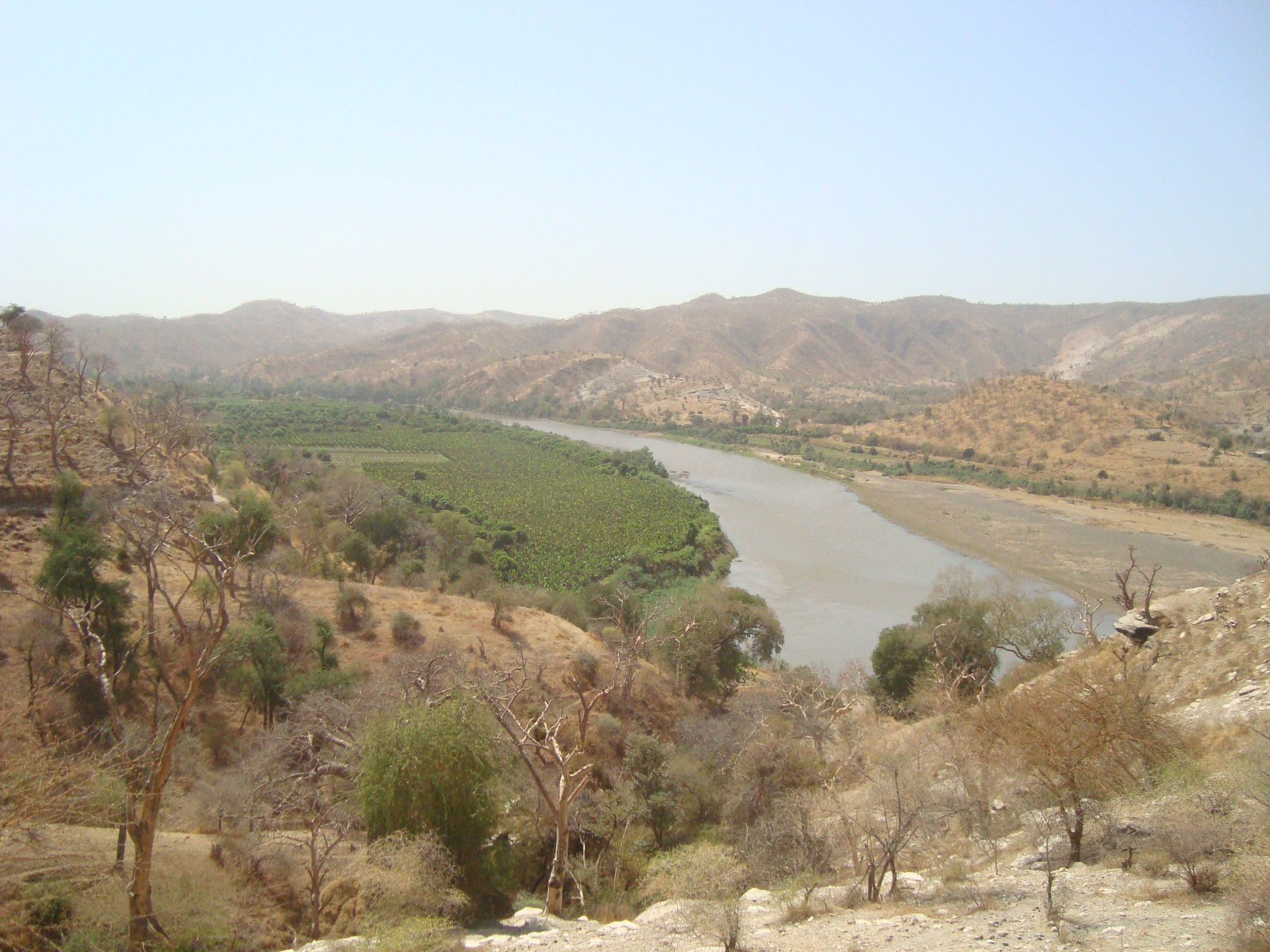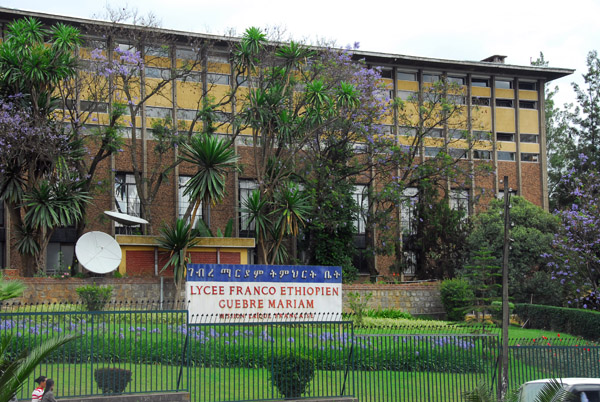|
Tahtay Adiyabo
Tahtay Adiyabo () is a woreda in the Tigray Region of Ethiopia. Part of the North Western Zone, Tahtay Adiyabo is bordered on the south by Asigede Tsimbela, on the southwest by the Tekezé River on the north by Eritrea, and on the east by La'ilay Adiyabo; part of the northern border with Eritrea is delineated by the Mareb River. The northernmost point of this woreda is the northernmost point of Ethiopia. Towns in this woreda include Addi Awuala and Addi Hageray. The town of Sheraro is surrounded by Tahtay Adiyabo. History On 26 September 1976, on the eve of Meskel, the Tigray People's Liberation Front (TPLF) turned back an advance by an armed detachment of 250 Ethiopian Democratic Union fighters at Chiameskebet, a village near Shiraro, on 26 September 1976, forcing them to retreat across the Tekezé. Both sides suffered heavy casualties; amongst the TPLF wounded was their general, Mehari Tekle ("Mussie"), who was fatally wounded in the battle and died a few days later. ... [...More Info...] [...Related Items...] OR: [Wikipedia] [Google] [Baidu] |
Tigrayan People's Liberation Front
The Tigray People's Liberation Front (TPLF; ), also known as the Tigrayan People's Liberation Front, is a left-wing ethnic nationalist, paramilitary group, and the former ruling party of Ethiopia. It was classified as a terrorist organization by the Ethiopian government during the Tigray War until its removal from the list in 2023. In older and less formal texts and speech it is known as Woyane () or Weyané (). The TPLF was founded on February 18, 1975, in Dedebit, Tigray. Within 16 years, it grew from about a dozen men to become the most powerful armed liberation movement in Ethiopia. Unlike the Eritrean or Somali liberation fronts at the time, the TPLF did not seek independence from the Ethiopian state; instead, it aimed to overthrow the central government and implement its own version of the Ethiopian revolution. From 1989 to 2018, it led a political coalition, the Ethiopian People's Revolutionary Democratic Front (EPRDF). It fought a 15-year-long war against the Derg ... [...More Info...] [...Related Items...] OR: [Wikipedia] [Google] [Baidu] |
Water Supply And Sanitation In Ethiopia
Access to water supply and sanitation in Ethiopia is amongst the Water supply and sanitation in Sub-Saharan Africa, lowest in Sub-Saharan Africa and the entire world. While access has increased substantially with funding from Foreign aid to Ethiopia, foreign aid, much still remains to be done. Some factors inhibiting the achievement of these goals are the limited capacity of water bureaus in the country's nine regions, two city administrations and water desks in the 770 districts of Ethiopia (''woreda''s); insufficient cost recovery for proper operation and maintenance; and different policies and procedures used by various donors, notwithstanding the Aid effectiveness#Paris Declaration on Aid Effectiveness, February 2005, Paris Declaration on Aid Effectiveness. In 2001 the government adopted a water and sanitation strategy that called for more decentralized decision-making; promoting the involvement of all stakeholders, including the private sector; increasing levels of cost reco ... [...More Info...] [...Related Items...] OR: [Wikipedia] [Google] [Baidu] |
Education In Ethiopia
Education in Ethiopia was dominated by the Ethiopian Orthodox Church for many centuries until secular education was adopted in the early 1900s. Prior to 1974, Ethiopia had an estimated literacy rate below 50% and compared poorly with the rest of even Africa in the provision of schools and universities. After the Ethiopian Revolution, emphasis was placed on increasing literacy in rural areas. Practical subjects were stressed, as was the teaching of socialism. By 2015, the literacy rate had increased to 49.1%, still poor compared to most of the rest of Africa. Recently, there has been massive expansion throughout the educational system. Access to primary schools is limited to urban locations, where they are mostly private-sector or faith-based organizations. Formal education consists of in total 12 grades. Primary school education consists of two cycles: grades 1 to 4 and 5 to 8. Secondary schools also have two cycles: grades 9 to 10 and 11 to 12. Primary schools have over 90% of ... [...More Info...] [...Related Items...] OR: [Wikipedia] [Google] [Baidu] |
Kunama Language
The Kunama language has been included in the proposed Nilo-Saharan languages, Nilo-Saharan language family, though it is distantly related to the other languages, if at all. Kunama is spoken by the Kunama people of the Gash-Barka Region in western Eritrea and just across the Ethiopian border. The language has several dialects including: Barka, Marda, Aimara, Odasa, Tika, Lakatakura, Sokodasa, Takazze-Setit and Tigray. Ilit language, Ilit and Bitama language, Bitama are not mutually intelligible and so may be considered distinct languages. There have been some use of the Kunama language in publications. "The first Bible translation product in Kunama was the Gospel of Mark prepared by Andersson and published in 1906." Phonology Consonants * is only of marginal status. * are labialized as after back vowels. * is heard as aspirated in syllable-initial position. Vowels * can be heard as when in unstressed syllable position. See also *Wiktionary:Appendix:Kunama word ... [...More Info...] [...Related Items...] OR: [Wikipedia] [Google] [Baidu] |
Kunama People
The Kunama are an ethnic group native to Eritrea. They are one of the smallest ethnic communities in Eritrea, constituting only 4% of the population. Most of the estimated 260,000 Kunama live in the remote and isolated area between the Gash and Setit rivers near the border with Ethiopia. The Kunama people have ancient ancestry in the land of Eritrea. In the 2007 Ethiopian census, however, the number of Kunama in Tigray dropped to 2,976, as the remaining 2,000 or so members of this ethnic group had migrated into the other regions of Ethiopia. History The earliest written mention of the Kunama comes from Ya'qubi, writing around 872 AD. His account is based on travelers' reports. He noted the 'Cunama' tribe living on the eastern borders of Alodia. They were later mentioned by the 10th century Arab geographer Ibn Hawqal. He states they lived in the Barka valley, and fought with bows, poisoned arrows and spears, but did not use shields. He also mentions that the Kunama worship a go ... [...More Info...] [...Related Items...] OR: [Wikipedia] [Google] [Baidu] |
Tigrayans
The Tigrayan people (, ''Təgaru'') are a Semitic-speaking ethnic group indigenous to the Tigray Region of northern Ethiopia. They speak the Tigrinya language, an Afroasiatic language belonging to the Ethiopian Semitic branch. The daily life of Tigrayans is highly influenced by religious concepts. For example, the Christian Orthodox fasting periods are strictly observed, especially in Tigray; but also traditional local beliefs such as in spirits, are widespread. In Tigray the language of the church remains exclusively Ge’ez. Tigrayan society is marked by a strong ideal of communitarianism and, especially in the rural sphere, by egalitarian principles. This does not exclude an important role of gerontocratic rules and in some regions such as the wider Adwa area, formerly the prevalence of feudal lords, who, however, still had to respect the local land rights. Tigrayans are branched out across the world in diaspora communities but are native residence of Tigray. Areas wh ... [...More Info...] [...Related Items...] OR: [Wikipedia] [Google] [Baidu] |
Islam In Ethiopia
Islam is the second largest religion in Ethiopia behind Christianity. In 2024, 31.5% of the population was Muslim. Islam in Ethiopia dates back to the founding of the religion; in 615, when a group of Muslims were counseled by Muhammad to escape persecution in Mecca and Migration to Abyssinia, migrate to the Kingdom of Aksum which was based in Ethiopia and which was ruled by Najashi, a pious Ethiopian Orthodox, Christian king. It is agreed by Islamic scholars that Najashi First Hejira, gave shelter to the Muslim refugees around 615–616 at Axum. Bilal ibn Ribah, the first Muezzin, the person chosen to call the faithful to prayer, and one of the foremost companions of Muhammad, was born in Mecca to an Abyssinian (Ethiopian) mother. Introduction Islam was in 2007 the second largest religion in Ethiopia with over 33.9% of the population. The faith arrived in Tigray Region, Tigray, north of Ethiopia, at an early date, shortly before the Hijra (Islam), hijira. The Kingdom of Ak ... [...More Info...] [...Related Items...] OR: [Wikipedia] [Google] [Baidu] |
Ethiopian Orthodox Christianity
The Ethiopian Orthodox Tewahedo Church () is the largest of the Oriental Orthodox Churches. One of the few Christian churches in Africa originating before European colonization of the continent, the Ethiopian Orthodox Tewahedo Church dates back to the Christianization of the Kingdom of Aksum in 330, and has between 36 million and 51 million adherents in Ethiopia. It is a founding member of the World Council of Churches. The Ethiopian Orthodox Tewahedo Church is in communion with the other Oriental Orthodox churches (the Eritrean Orthodox Tewahedo Church, the Coptic Orthodox Church of Alexandria, the Malankara Orthodox Syrian Church, the Armenian Apostolic Church, and the Syriac Orthodox Church). The Ethiopian Orthodox Tewahedo Church had been administratively part of the Coptic Orthodox Church of Alexandria from the first half of the 4th century until 1959, when it was granted autocephaly with its own patriarch by Pope Cyril VI of Alexandria, Pope of the Coptic Orthodox Chur ... [...More Info...] [...Related Items...] OR: [Wikipedia] [Google] [Baidu] |
Central Statistical Agency (Ethiopia)
The Central Statistical Agency, also known as the Ethiopian Statistical Service (ESS; Amharic: የኢትዮጵያ ስታቲስቲክስ አገልግሎት), is an Ethiopian government agency designated to provide all surveys and censuses for that country used to monitor economic and social growth, as well as to act as an official training center in that field. It is part of the Ethiopian Ministry of Finance and Economic Development (Ethiopia), Ministry of Finance and Economic Development. The Director General of the ESS is Beker Shale (Ph.D.). Before 9 March 1989 the ESS was known as the Central Statistical Office (CSO). The ESS has 25 branch offices. Besides the capital city of Addis Ababa, the cities and towns with offices are: Ambo, Ethiopia, Ambo, Arba Minch, Chiro (town), Chiro, Asayita, Assosa, Awasa, Bahir Dar, Debre Berhan, Dessie, Dire Dawa, Gambela, Ethiopia, Gambela, Goba, Gondar, Harar, Hosaena, Inda Selassie, Jijiga, Jimma, Mek'ele, Mizan Teferi, Adama, Negele Borana, ... [...More Info...] [...Related Items...] OR: [Wikipedia] [Google] [Baidu] |
Battle Of Chiameskebet
A battle is an occurrence of combat in warfare between opposing military units of any number or size. A war usually consists of multiple battles. In general, a battle is a military engagement that is well defined in duration, area, and force commitment. An engagement with only limited commitment between the forces and without decisive results is sometimes called a skirmish. The word "battle" can also be used infrequently to refer to an entire operational campaign, although this usage greatly diverges from its conventional or customary meaning. Generally, the word "battle" is used for such campaigns if referring to a protracted combat encounter in which either one or both of the combatants had the same methods, resources, and strategic objectives throughout the encounter. Some prominent examples of this would be the Battle of the Atlantic, Battle of Britain, and the Battle of France, all in World War II. Wars and military campaigns are guided by military strategy, whereas battl ... [...More Info...] [...Related Items...] OR: [Wikipedia] [Google] [Baidu] |







